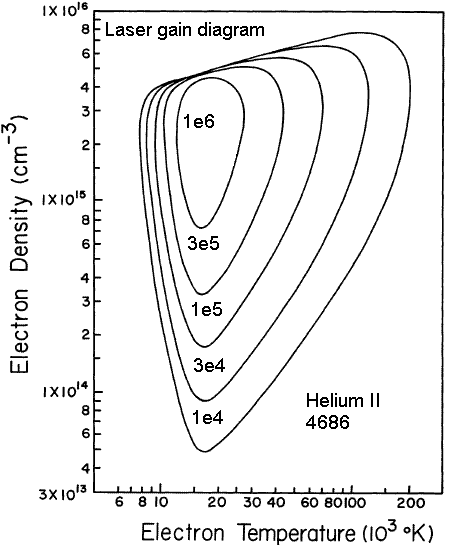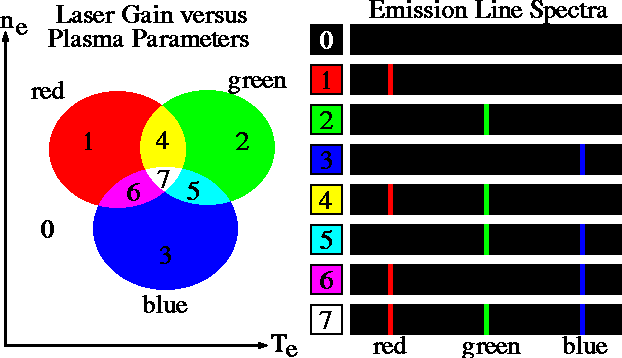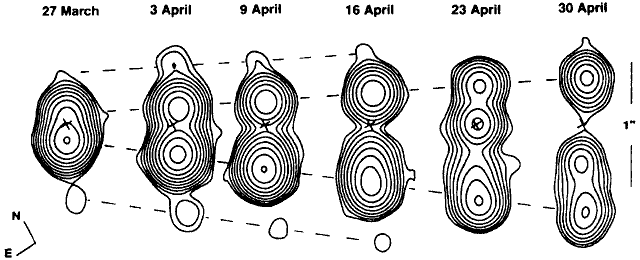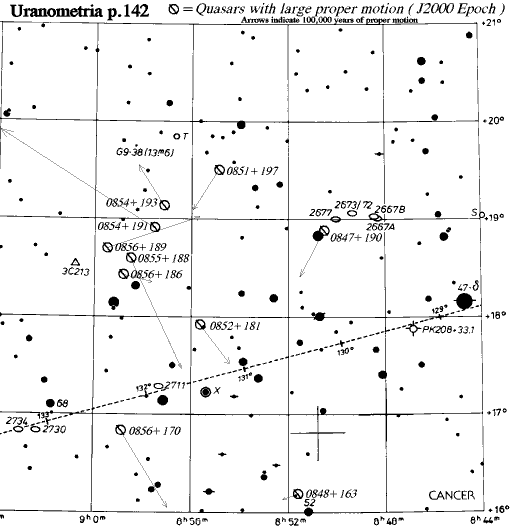When the spectrum of the star-like object 3C 273 was first observed in 1963, it was found to have one strong emission line and one medium/weak strength line. The problem was, however, that these lines were at wavelengths where no strong lines were expected from laboratory spectra. It has been a traditional assumption in astronomy that the intensities of lines in astronomical sources will be similar to those in the laboratory under ordinary excitation conditions. Schmidt assumed that these two lines were redshifted hydrogen-α and hydrogen-β lines, and obtained a redshift of 0.157. Subsequently, when other such objects with broad emission lines were discovered (3C 48, 3C 191 etc) they were also labelled quasars and the spectra were similarly interpreted on the redshift hypothesis. In conjunction with Hubble's law it meant that quasars were very distant objects. This in turn led to the well known difficulties concerning their energy generation mechanism, optical variability, lack of correlation in the redshift-magnitude diagram, superluminal motion etc.
Theoretical and experimental investigations in physics in the next decade showed that when a high temperature plasma rapidly expands (for example, in vacuum) the resulting cooling leads to a population inversion in the lower levels of the atom, and this can lead to laser action. Also, it is well known that in certain types of stars (Wolf-Rayet, P Cygni); matter is ejected more or less continuously. This led Varshni to propose the following realistic model of a quasar: A quasar is a star in which the surface plasma is undergoing rapid radial expansion giving rise to population inversion and laser action in some of the atomic species. The assumption of the ejection of matter from quasars at high speed is supported from the fact that the widths of emission spectral lines observed in quasars are typically of the order of 2000 - 4000 km/sec. The ejected matter can form a nebulosity around the quasar or dissipate into space, depending on the rate of mass loss, how long the ejection has been going, the surroundings of the quasar etc. Laser action is enhanced if the hot plasma ploughs into this colder gas. Thus no redshifts are required to explain the strong emission lines. This model is called the plasma-laser star (PLAST) model.
Laser stars are very hot emission lines stars with strong stellar winds that produce plasma recombination lasers. Rapidly cooling highly ionized plasmas can generate a population inversion. The following schematic illustrates two prominent rapid cooling mechanisms :
 Figure 1.
Figure 1.
1. Adiabatic expansion cooling is a
non-equilibrium flow which occurs near the stellar photosphere (on the left).
Similar to the supersonic throat region of a
gasdynamic laser and in laser generated
plasma recombination lasers.
2. Gas contact cooling
occurs a little further away from the photosphere, when
hot plasma encounters cooler plasma or cold circumstellar gas and dust.
The TPD-I series of experiments
achieved laser action purely by gas contact (no expansion).
 Figure 2. Laser gain as a function of plasma parameters for He II 4686 Å.
Figure 2. Laser gain as a function of plasma parameters for He II 4686 Å.
The maximum laser gain occurs in a narrow range of plasma parameters which
depends on the ion and the transition. Note that for this transition, in the
upper region of the plot, laser action becomes extremely sensitive to increasing
density and can cease abruptly. The same effect can happen to a lesser extent
when the initial temperature is lowered slightly from the maximum gain
temperature. If initial plasma parameters differ from the region of maximum gain
it is possible for laser action to cease and possibly another laser transition
in another ion would begin to dominate the spectra.
As an academic exercise we plot the laser gain diagram for three separate transitions, not neccessarily in the same ion. Let us assume that the transition wavelengths differ enough from each other that the emission lines are clearly distinguishable in the spectra. The diagram on the bottom left approximates the regions of maximum laser gain in each transition using colored red, green and blue circles.
 Figure 3. Laser star spectra.
Figure 3. Laser star spectra.
The spectra on the right occur when the plasma
parameters correspond to the numbered regions from the gain diagram on the left.
The large variety of possible spectra clearly demonstrates how small differences
in plasma parameters produce large differences in emission line strenghts.
This sensitivity to initial conditions produces the large variety of
laser emission lines found in quasar spectra.
Laser emission was suggested as a possible mechanism in quasars by Varshni in 1973. This prediction was later confirmed by numerous observations such as the recent unexpected discovery of naked quasars by the Hubble Space Telescope. The Hubble Space Telescope and the Kuiper Airborne Observatory have confirmed that stars with very strong stellar winds can generate laser emissions. Known stars such as GRS 1915+105 and GRO J1655-40 have high speed jets and spectrum similar to the quasars. These stars and are commonly named microquasars. High velocity ejections also occur in young stellar objects (YSO), x-ray novae, central stars of planetary nebula, symbiotic stars, novae, supernovae, and in many laser stars such as TON 202, 3C 345 and Cygnus-A.
 Figure 4. Series of VLA radio images of the star GRS 1915+105
taken at wavelength of 3.5 cm, depicting rapid ejection over the span of a month
(March 27 to April 30, 1994).
Figure 4. Series of VLA radio images of the star GRS 1915+105
taken at wavelength of 3.5 cm, depicting rapid ejection over the span of a month
(March 27 to April 30, 1994).
A spectacular confirmation of a laser star theory prediction occurred in 1982 with the discovery of significant quasar proper motion, but first some historical background. The cosmological quasar model rests solely on the assumption that quasars are enormously distant, billions of lightyears beyond our galaxy. A crucial experiment is a test or observation which can rule out a hypothesis or a model. The following crucial experiment is based on careful observations published by the respected astronomer W. J. Luyten (1969), he used the well-known Palomar observatory 48-inch Schmidt telescope. His measurements clearly demonstrates significant proper motion for 40 quasars. Luyten is considered an impartial source because he was unaware that these stars were quasars.
 Figure 5. Quasar proper motion vectors
Figure 5. Quasar proper motion vectors
We define the term 'proper motion' as the apparent motion of a star across the celestial sphere at
right angles to the observer's line of sight. This star chart contains the proper motion
direction and value for 10 quasars from Luyten's 1969 list. These quasars are very
faint, approximately 18 magnitude
For example the proper motion of quasar Ton 202 is 52.6 milliarcseconds/year. For comparison the largest proper motion reported up to now for a planetary nebula central star is is 40 milliarcseconds/year for NGC 7293 (the nearest planetary nebula). Proper motions for all other planetary nebulae are smaller than 24 milliarcseconds/year. The distance of NGC 7293 is estimated to be 690 light years, from this it would be reasonable to estimate that quasar Ton 202 is within 1000 lightyears from the Sun. This distance is a factor of a million closer than cosmologists claim. Ton 202 is a laser star within our galaxy. Purely as an academic exercise let us assume that the standard quasar model is correct : We find that the transverse velocity corresponding to the proper motion of Ton 202 is 1100 times the speed of light. (using H = 50 km/sec per Mpc, q0 = 0 and z = 0.366). The cosmological quasar model fails this crucial experiment.
Having independently established the fact that quasars are stars (via proper motion evidence), the laser star model is the first theory to explain the unusual emission lines. It resolves the well known difficulties concerning quasars, e.g., their energy generation mechanism, optical variability, lack of correlation in the redshift magnitude diagram, apparent brightnesses not diminishing with increasing redshift, superluminal motion etc. Most of the observational evidence on quasars either supports the laser star theory, or is consistent with it.
| The great tragedy of Science - the slaying of a beautiful hypothesis by an ugly fact. |
| Thomas Henry Huxley 1825-1895 |